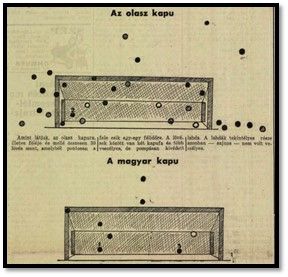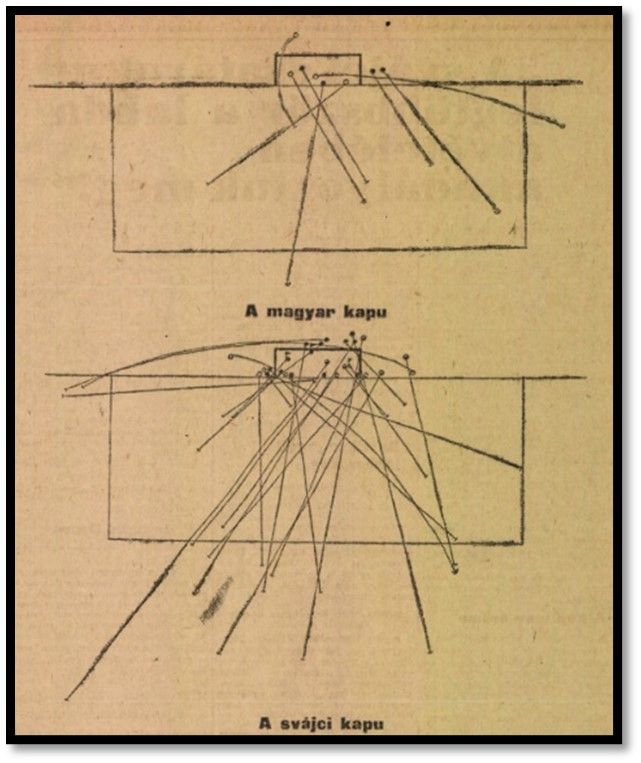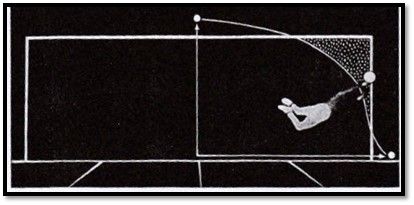The first part of a deep dive into the early usage of numbers and diagrams to analyse goalkeeper performance.
The recording of football data, and using it to inform coaching and playing decisions, has been going on for longer than many realise. Early attempts in France to draw diagrams of how goals were scored date back as far as the 1890s. In 1909 a newspaper reporter in the USA was analysing offsides, corners and free kicks.
These were the things that were easiest to note down while watching a game. More complicated analytical practices were attempted in the 1950s by Englishman Charles Reep. He had success as an advisor at Brentford, Wolves and Sheffield Wednesday by recording passing moves, possessions, crosses and, later, shots at goal.
Little of this was initially useful to goalkeepers, but between the wars work had been done that would begin to put goalkeepers under the mathematical spotlight, though it has only recently become more widely researched.
In Hungary the Nemzeti Sport newspaper published its first ‘Match Graph’ in November 1922. This looked like the read-out from a heart monitor and showed the movement of the ball up and down the pitch during the course of a match. Other innovations in the same paper included the (now-grainy) ‘Target Table’.

For the first time a goalkeeper could see a graphical image that instantly showed where teams were placing their shots. Rather than note where shots originated from it showed where they ended up, like an early version of a post-shot-expected-goals plot. Not only did these tables show the location of each attempt but they were broken down in to three strengths of shot from ‘really weak’ to ‘strong’ and gave each one a different shade.
Over the course of a season a goalkeeper could collect these charts and see where particular teams placed their shots, and which ones were most likely to be most difficult to save.
Nemzeti Sport managed to continue to publish during the Second World War and added a ‘New Target Table’ in 1942.

This showed a 2-D representation of the penalty area and the location and flight path of each shot. Whilst today these diagrams may seem basic, they were revolutionary for their time.
It wasn't until the 1950s that the FA, under the direction of Walter Winterbottom, saw the potential of football data. He instigated a wide-ranging programme of investigations. From off-field data, like the effect of league position on attendance figures or asking whether the four divisions becoming more competitive, to on-field data such as the distance travelled by players during a match and where goals are scored from, investigations increased. Goalkeepers were low-down on their list of priorities, but one study in 1955 was of use. It was the first known analysis of penalty kicks.
Using the best technology they had to hand, which was a cine camera, a series of experiments were carried out at St. James’ Park. First a pair of professional players, Newcastle United’s Jackie Milburn and Charlie Crowe, were filmed shooting into an empty net. Milburn was tasked with shooting as hard as he could and Crowe was asked to take a side-foot shot placed into the corners. The footage was played back to see how many frames of film elapsed between the ball being kicked and when it reached the goal.
Knowing the speed of the film allowed the researchers to calculate an accurate time taken for the ball to travel into the goal. In true analogue detail of the time, Milburn’s blasts took 29/64ths of a second while Crowe’s placed shots took 50/64ths of a second.
Then the researchers looked at three goalkeepers to see how much of the goal they could cover and how long it took them to reach the crossbar above them, the post to one side and to the top corner of the goal.
The three goalkeepers used were a professional (United’s Ron Simpson) who, in another sign of the times, measured just 5ft 9 ½ inches, a 17 year-old trainee who stood 5ft 10 ½ inches and a 14 year old schoolboy who was exactly 5 ft tall. Each made a number of dives to see how much of the goal they could cover, with Simpson, though slightly shorter, being able to guard more net than the 17 year-old trainee:

The time taken to reach the different zones was measured by again counting frames of film. The results, while not surprising, did reinforce how difficult it is to save a well-struck penalty. It took the professional goalkeeper 1 and 13/64ths of a second to reach the post which was too slow unless they could anticipate and move before the ball was struck. Likewise it took 1 and 9/64ths of a second to get as far to the top corner as possible. Too slow again, but also not far enough if the ball was struck deep into the corner. While this didn’t exactly unearth any new ideas, it did quantify things. A goalkeeper really needed to be able to anticipate the direction of the shot to have a chance of saving it, or move early.
The next published work was a decade later when Charles Reep appeared again in the 1960s. He came up with the first published goalkeeper-specific data in the press via the Daily Mail. He had begun recording individual, rather than team, data with H. Andrew Thomas. The Mail ran a series of articles where Reep compared and contrasted various pairs of players vying for inclusion in the 1966 England World Cup squad. For the number one shirt, he looked at three games each for Leicester City’s Gordon Banks and Sheffield Wednesday’s Ron Springett.
Interestingly, Reep - in a very modern way - split his analysis into Distribution, and Saves and Collections. Distribution was broken down into six areas – long and short throws, kicks from the hands, and goal kicks. While these were small sample sizes it did give an insight in to how the game was played at the time.
When the goalkeepers had the ball they inevitably tried a long pass. Banks went long 82.5% and Springett 84% of the time, though Springett used a short goal kick 40% of the time. Overall Banks was more accurate with long throws and kicks with 54% compared to Springett’s 35%. Neither was very impressive.
Over the three games each goalkeeper faced 32 shots on target. Banks saved 24 and Springett 25, though no indication of the location or difficulty of the shots was given. Banks was ahead on balls caught and punched and number of times he advanced to smother the ball, though Springett intercepted 21 times compared to Banks' 13.
Neither was ‘credited’ with a fumble.
Rob Haywood is the author of the forthcoming book Many Impossible Things: The Ingenious Evolution of Football Data. Rejoin us for the second part of this investigation into the history of goalkeeper data next week.
On the other end of the timeline, Dr John Harrison and Goalkeeper xG utilise the most advanced goalkeeper statistical modelling techniques to help clubs recruit, improve, and produce better goalkeepers. See our previous work here, and get in touch with Dr Harrison at [email protected].








